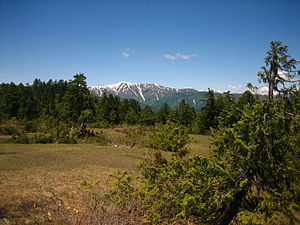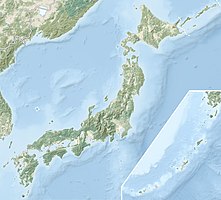Oze National Park
|
Oze National Park
|
||
|
Mountains in the Oze National Park |
||
| location | Japan | |
| surface | 372 km² | |
| WDPA ID | 555575152 | |
| Geographical location | 36 ° 47 ' N , 139 ° 39' E | |
|
|
||
| Setup date | August 30, 2007 | |
| administration | Japanese Ministry of Environment | |
The Oze National Park ( Japanese 尾 瀬 国立 公園 , Oze Kokuritsu Kōen ) is a protected area in Japan . It is located in the prefectures of Fukushima , Gunma , Niigata and Tochigi on the island of Honshu about 150 km north of Tokyo. Originally the area belonged to the Nikko National Park , but was expelled in 2007 as an independent reserve and covers 37,200 ha. Since 1960, the area also is a natural landmark .
Landscape image
Of particular importance in the national park are Japan's largest marshland with 650 hectares, the Ozegahara swamp and the Hiuchigatake ( 燧 ヶ 岳 ) mountains with a maximum height of 2536 meters and the Shibutsu with 2228 meters. Other striking mountains are the Aizu-Komagadake ( 会 津 駒 ヶ 岳 ) and the Taishaku ( 帝 釈 山 ). Lake Ozenuma ( 尾 瀬 沼 ) was created by lava built up during a volcanic eruption.
The climate here is characterized by cool summers and long, often snowy winters.
plants and animals
There are extensive oak, beech, birch and conifer forests in the mountains. In the marshes you can find large populations of the white Scheinkalla and Middendorff's daylily Hemerocallis middendorffii. On the Aizu-Komagatake there are larger populations of the Marie's firs endemic to Honshu .
A total of 930 plant species, including 21 endemics , 40 dragonfly and 30 butterfly species, as well as numerous bird and mammal species have been identified.
Among the identified mammal and bird species are: a. the black- headed ibis , mandarin duck , collar bear , sika deer and the hondo ermine are particularly noteworthy.
tourism
The numerous flowers of the kalla attract numerous hikers at the end of May / beginning of June, who can explore the marshland of Ozegahara on wooden footbridges. In July and August, many visitors come to the higher regions of the park, as the daylilies bloom there. As the park cannot be hiked through in one day, huts are available for overnight stays.
Web links
- World Database on Protected Areas - Oze National Park (English)
- Information about the national park
- Information on the national park website, accessed November 3, 2014
Individual evidence
- ↑ a b c d Explanations on the BCT website
- ↑ Explanations on the website of the Oze National Park, in English, accessed on November 3, 2014 ( Memento of the original from May 23, 2013 in the Internet Archive ) Info: The archive link was inserted automatically and has not yet been checked. Please check the original and archive link according to the instructions and then remove this notice.
- ↑ Recommendations for excursions by the Koslowski language school, accessed on November 3, 2014

